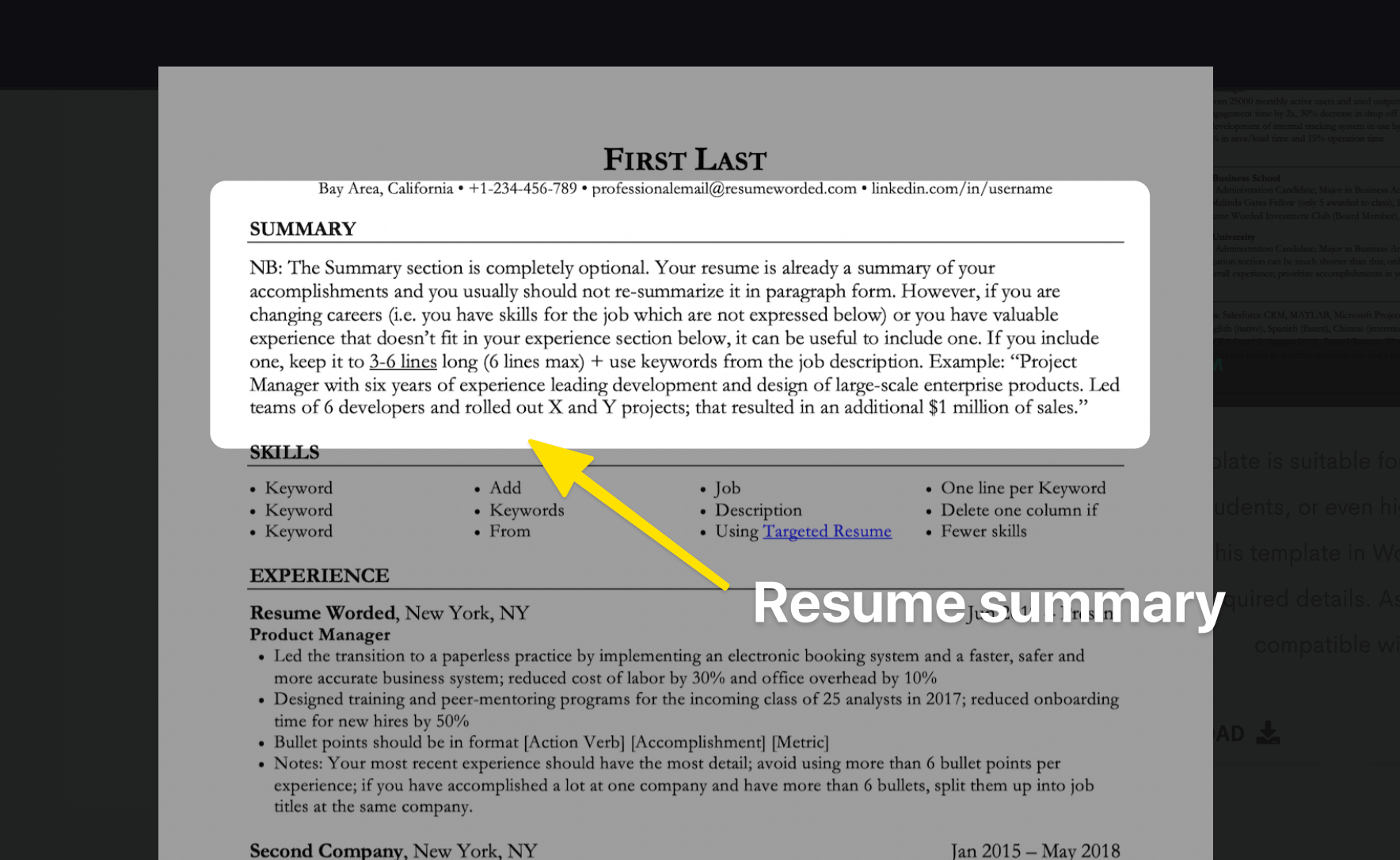A recent study by Glassdoor indicated that 98 percent of applicants are rejected based on their resumes alone.
That's ridiculous. And quite frankly, unfair. How can a company evaluate all of your skills, achievements and experiences from one piece of paper?
That's why we wrote this article.
Over the past week, we reached out to a number of hiring managers, recruiters and career coaches to find out exactly what they're looking for when they skim through your resume. After reading this article, you'll know exactly what your future employers are looking for when they read your resume.
At Resume Worded, we believe that content is the most important element of your resume, so that’s the focus of these resume tips and tricks. If you're looking for a resume template that is ATS-compatible — in other words, readable by automated computer screeners — see our ATS resume templates.
If you want to confirm that your resume passes the ATS resume test, upload it to our resume scanner for a free ATS resume scan.
Resume Tip #1: Use short, succinct bullet points. Not paragraphs.
If a recruiter was to pick up your resume right now, how easy would it be for him/her to skim it in 30 seconds and get a sense of your experiences and accomplishments? This is what we call the '30 second skim', and your resume needs to be optimized for it.
Short, succinct bullet points are key to your resume's readability. Blobs of text, that is bullets or paragraphs that are three lines or longer, are likely to not be read.
If you’re not sure if your resume’s content is the right length, upload it to the tool below — it’ll give you feedback on your resume length, and other key criteria recruiters and hiring managers care about.
Resume Tip #2: Ditch the objective section from your resume
All recruiters agree that an Objective is superfluous on a resume. The company already knows what you’re looking for because you applied for a specific position. Having an objective section may even exclude you from other similar positions that might be interesting to you.
Resume Tip #3: Only add a Summary section if you need one!
With a few exceptions, a Summary section generally does little for your resume apart from duplicating your achievements and wasting space.
Your resume is already meant to be a concise summary of your achievements.
There's no need to re-summarize it in a paragraph form. The only exception to this rule is if you need to add important information that is not already in another section on your resume. This is key — don't duplicate achievements on the rest of your resume into your summary!
For example, if you're looking to completely change your career & role (e.g. moving from software engineering to marketing), you could use 1-2 lines to direct a recruiter to the specific roles you are looking for. If you do decide to include a summary, ensure that it is not filled with fluffy, subjective buzzwords like "team player" or "hard worker".
If you decide you need a resume summary, check out the Resume Summary Generator for inspiration. If you are changing careers, read our guide on how to write a resume summary for career changers.
Resume Tip #4: Order your resume's sections based on job requirements
Recruiters skim your resume from top to bottom, so be smart about how you position your sections.
"You need to ask, is there anything that may automatically disqualify me from contention and either don’t include it or move it.
For example, if a specific degree is required, and you have another degree, or no degree move the Education section to the bottom of your resume."
This tip is from Dory Wilson, from Your Office Mom.
Related: Resume 101: The Correct Order for Resume Sections
Resume Tip #5: Tailor your resume to include relevant achievements
James Rice, from WikiJob, tells Resume Worded: "Never send in a generic resume for a job. Even if you are applying for multiple jobs in quick succession, it is well worth the time it takes to tailor your resume to each and every position you are applying for.
Don’t just include everything you have ever done; make sure all the space on your resume is spent telling the recruiter why you are perfect for that particular job. If you have education or skills that are not relevant to the position, then think about leaving them out or explain succinctly why they show relevant transferable skills."
Related: Top 12 Resume Boosters To Quickly Improve Your Resume
Resume Tip #6. Add keywords from the job description into your resume
When writing a resume that is being initially reviewed by an automated screening process, the absolutely most critical step you can take to make sure that you make it through the initial phase is to add keywords that are in the job description to your resume.
Why? The vast majority of these screening processes are not sophisticated and simply check your resume for keywords that are relevant to the job. If they’re found in sufficient quantity, your resume will be passed onto a human for further review. If not, you will be instantly rejected, regardless of whether you are qualified for the position. Thought this may seem like a sneaky move, I can assure you it will cause your success rate to skyrocket.
This tip is from Rich Franklin, Founder of KBC Staffing
You can evaluate whether your resume is well targeted to the job you're applying for by trying out Targeted Resume. It is an ATS resume keyword scanner that tests if your resume is well targeted to the job description.
You can also use the skills search tool below to get a list of skills and keywords relevant to the job you’re applying for.
Resume Tip #7: Achievement-oriented, not responsibility oriented
"Your resume should be achievement-based. Simply regurgitating your job description into multiple bullets is no longer effective. This strategy does nothing to show if you've even done your job well. It also doesn't provide employers with much context to how you can help them. I always recommend that my clients research pain points and appeal directly to those needs with relevant achievements. For example: A company may be looking for an administrative assistant with Instagram experience. Who would you be more likely to ask for an interview between these two?
Option 1: Run departmental social media pages.
Option 2: Increased Instagram following by 58% by developing engaging content, attending Instagram for Business online course, and staying up to date on emerging marketing trends."
This tip is from Brett Ellis, who runs Brett Ellis Career Marketing Services
Resume Tip #8: Quantify your resume!
"Rather than wording your resume to read like a job description (current or prior positions) use it as a guide to identify what’s most important relative to the role you are seeking. On those points, add keywords and details that reflect your success. All the performance metrics and KPIs are at play here.
If you had a hand in reducing, increasing, changing anything in your job, mention it. Don’t wait until the 5th bullet point to note you were instrumental in modifying a process that saved the company $50K, or you are 250% over quota.
Whatever it is, mention it to substantiate how you impact the bottom line. And, don’t be shy. If you were on a team that supported these efforts, you still had a hand in it. Too many people say, “well, I didn’t do it all by myself,” and don’t mention it, rather than stating they were part of a team that did. If you don’t know where to start, review your bullet points and ask the question “why is this important?” or “okay, so what?” to help you. Whether it’s your performance reviews or other documentation, review it to support your statements.
This tip is from Dory Wilson, from Your Office Mom.
For more information on quantifying your resume, check out our blog post on how to use numbers and metrics to write effective resume bullet points.
Resume Tip #9: Use an easy to understand job title
"One of the first things I look at as a recruiter, is a candidates current job title. I then look at company, tenure and previous job titles. Education comes second."
"It is common to have inventive job titles, which make it unclear what someone is actually responsible for. Equally it is common to see someone’s title as their level, e.g. Vice President or Director. This doesn’t make what you do immediately apparent. It is important to be truthful, so don’t make up a title. However, if your job is a waitress, call yourself a waitress and not a customer satisfaction representative or a customer service specialist."
"Your resume is likely to get less than 30 seconds of attention and you probably have 5 seconds to make an impact. You need to make this really easy for someone. You do that by making it clear that you are relevant to the job you are applying to."
This tip is from Karla Reffold from BeecherMadden.
Resume Tip #10: Make sure your resume is readable by Applicant Tracking Systems
Companies get hundreds of applicants for each job. It's pretty unfeasible to expect a hiring manager to manually review each and every application, including those that may not have the right experience for the job.
This is why companies use ATS or Applicant Tracking Systems. They are automated software that electronically parse and process your resume, reducing the number of resumes hiring managers have to manually review. Go here if you need an ATS-ready resume template.
If you want to check if your resume can be read by ATS, try out our ATS resume checker here.
Erica McCurdy, from McCurdy Life Coach, stresses the importance of matching your resume to the job description: "If you are submitting your resume online, you will want to make sure you incorporate the major points and keywords from the job description in your resume and make sure you are using a format that is ATS optimized."
Steph, from Off The Clock Resumes, also had these 6 tips to add about how to make sure your resume is readable by ATS:
- "ATS can’t read text placed in headers or footers.
- ATS can’t read text placed in charts, tables, or text boxes.
- ATS doesn’t care about bold, underlined, italicized, colored, or color-filled text.
- ATS doesn’t see photos embedded in your resume (JPG or PNG files)
- ATS scans the text from left-to-right so it may not read text formatted in columns correctly."
Make sure you also upload your resume to the following tools to confirm it is ATS compliant:
- Resume Scanner: Upload your resume and get a free ATS resume scan
- Targeted Resume: Add your job description and we'll evaluate whether it is well targeted to the resume.
Related: Resume Trends To Follow in 2025
Resume Tip #11: If you're a programmer, list online projects or your Github
"If you're a programmer, be sure to list skills, languages, and frameworks clearly for the benefit of recruiters and hiring managers. Including a link to your Github profile or specific projects you've worked on will also enable resume reviewers to see your talent in action.
Recruiters often look for precise skills tied to the role so listing your proficiencies will help separate you from other resumes. Your Github profile and projects will help for hiring managers to see what you've worked on clearly."
This tip is from Beth Cohen, a Senior Recruiter at Fundera.
If you're not a programmer, you can still include links to your projects, whether that is your blog or your online portfolio.
Resume Tip #12: Use a clean resume template
Keep your resume design clean without a lot of clutter, colors, different fonts, or graphs. These can be easily overdone and when you're a recruiter reading hundreds of resumes, it's just too much to look at so you move on.
This tip is from Becky, from Go Write2Hire.
Additionally, using fancy styles and fonts increases the chance that your resume will be processed incorrectly by ATS. If you're unsure if your resume will be processed correctly by ATS, upload it for a free ATS resume scan.
Resume Tip #13: Organize your sections effectively
"Use separation to create visual space. Break up your past work experiences into sections and sub-sections, with at least a blank line of uniform spacing between each. Use section headers as an organizational tool."
"You want the reader of your resume to be able to go down your list—from one past work experience to the next—without all of the details blending together. However, don't use text boxes to do this; they tend to look very tacky and are not compatible with company applicant tracking systems. You don’t want your resume to end up in the hiring manager’s trash file because of a formatting error."
This tip is from Jan Hudson from Surf Search.
You can find resume templates which are compatible with ATS here.
Resume Tip #14: Use a meaningful file name
Use FirstName-LastName.pdf (or similar) as the filename. Recruiters often save resumes in the same folder and you'll be surprised at how often resumes get lost because they're saved as "Resume.pdf"!
Resume Tip #15: Use the active voice, not the passive voice
Using the active voice not only ensures your resume is less wordy and more concise, it also makes it more impactful.
Stacy Caprio also had this example to add regarding using the active voice:
"Use active voice and not passive when writing your resume bullet points. This means saying things such as "I increased revenue by X, when I set up campaign X" and not "Campaign revenue increased by X when the campaign was set up".
The first active voice example makes it clear you were the one who initiated the action and got the results, which is key to standing out with your resume."
Editor's note: Resume Worded's free resume checker scans your resume for the active voice. Try it out here.
Resume Tip #16: Proofread your resume. No spelling or grammar errors!
Obvious stuff here, but you’d be surprised at how many resumes we’ve seen that have spelling or grammar mistakes. Ask a friend to review your resume!
James Rice from WikiJob also had this to add: It is absolutely essential that you proofread your resume. Many recruiters will throw away resumes that have typos or other errors. Don’t rely on spell-check to spot all errors, as many typos will not show up. Read over the document slowly and concentrate on every word; it is also a good idea to show it to a friend or tutor and ask them to have a read through. Make sure you send in a resume to be proud of.
Tip #17. Follow up after you apply for a role!
"Don’t 'submit and forget,' take the time to follow up and inquire on the status of your submission. Include a link to your LinkedIn and ensure it is current. Bonus points if you have some recent LinkedIn recommendations. And extra bonus points if you already follow the hiring company on LinkedIn."
This tip is from Stephanie Mahnken, who leads the hiring process at Directom.
Go to this link if you need sample follow up networking emails!
Tip #18: Cover letters are important too!
Karen Elkins Cohen is a Director of Human Resources, and she stresses the importance of a cover letter, in addition to your resume.
"It's not just your resume, but your cover letter. Your resume may not detail where you meet every qualification, so a well-written cover letter is what will get you in the door. If you use a template you see online, use the structure, but not the exact words!
"I'm seeing the same wording on multiple letters, "Thank you for the opportunity to apply for the position available at your company. Given the requirements in the job description, I am certain that I have the necessary skills to successfully do the job adeptly and perform above expectations." It's terrible.
"Instead, in your cover letter, tell me exactly how your experience meets my qualifications. If I'm asking for a year of supervisory experience and you've never been a supervisor, that's okay -- tell me about how your leadership experience (volunteer? college? church?) makes you a good supervisor.
Resume Tip #19: Ensure your resume is consistent with your online profiles (e.g. LinkedIn)
“Ensure that your resume matches up with your experience, education and qualification information that might be found on your online profiles. If a hiring manager spots any inconsistencies between the two, it may imply that you have something to hide.
It can also suggest that you haven’t put the care and attention in that’s expected when applying for a role and that you’re unaware of how to manage your personal online brand effectively – something which would be a red flag for those in commercial roles."
This tip is from Lars Herrem, from Nigel Wright Group.
Resume Tip #20: Avoid unnecessary industry jargon and acronyms
Keep the wording of your resume as simple as possible. Industry jargon and trade buzzwords are too niche, and you don't want to jeopardize your interview chances because the first HR staff member failed to understand it.
However, if the job ad calls for a particular acronym or buzzword in their requirements or qualifications, use it, of course. These are resume keywords.
This tip is from Christian Eilers, a career advice writer at Zety.com
Resume Tip #21: Use the right tenses to describe your achievements
We've said this before and we'll say it again, your resume is supposed to be a concise overview of your achievements — things you've achieved — and not your responsibilities.
This means that most of your bullet points should be in the past tense. After all, it's hard for something you accomplished to be written in the present tense. Most bullet points written in the present tense are often just responsibilities, and not things you actually accomplished. That said, there are some bullet points which can use the present tense — for example, if you're currently managing a team, you can use the present tense 'Manage' when describing your current role.
That's it from Resume Worded today! Thank you to all the contributors.
We hope you found these resume tips, hacks and tricks useful.
If you need more resources:
- Free resume review with Score My Resume
- ATS resume keyword scanner with Targeted Resume
- Free LinkedIn profile review with LinkedIn Review
If you have any questions, let us know! You can reach out to me directly on contact [at] resumeworded.com.
-Rohan
Founder, Resume Worded







